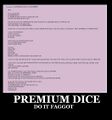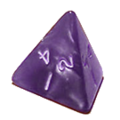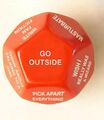Dice


Dice (singular: die) are high-impact polyhedra. In role-playing games and tabletop wargames, they are used as randomizers to inject an element of chance into the game. Non-gamers often only know about the six-sided die (hereafter referred to as the d6) thanks to the ubiquity of games like Monopoly and Yahtzee. Which dice are used tends to vary by system. Dungeons and Dragons, for instance, makes use of all types. On the other hand, White Wolf games and Classic Traveller use only ten- and six-sided dice, respectively. On the other hand, some games don't use dice at all! These tend to be relatively new games like Nobilis or Amber, or board games that use instead use the abomination known as a spinner (at first a result of war rationing, later used for non-numerical results).
Bear in mind, if you're not familiar with how statistics work, one d12 does not have the same probability distribution as two d6s (same goes for any combination of die). A single die of good quality will have the same percentage chance for any side to roll, whereas using multiple die will result in a probability distribution resembling a bell curve (in the two d6's case, seven will be the most common roll, followed by sixs and eights, then fives and nines, and so on). Keep this in mind when you're doing homebrew rules. Likewise, it's important to remember that dice can't roll 0, so the average is 0.5 higher than half the highest number (3.5 for a d6), not simply half.
If you do not have dice for whatever reason, consider chits getting some fucking dice. Or, since you clearly have a device with an internet connection if you're reading this, use one of the countless virtual dice rollers available online.
Dice are considered by most people to be impartial arbiters of random chance. Fa/tg/uys (and craps players) know better. Dice are controlled or at least influenced by the unseen force of Dice Mojo. It is believed that Dice Mojo can be influenced by players through manifold rituals, including:
- Placing a die with the desired number upward, that it 'gets used to' that position and tends to return to it.
- Placing a die with the desired number downward, that the die is tricked into thinking it has already made a bad roll and will produce a good outcome on the subsequent roll.
- Rolling a die until a string of good rolls are achieved, tapping into a streak of 'good mojo' or 'rolling out' bad outcomes.
- Various chants, prayers, threats, and curses made toward the die in order to entice or coerce it into producing favorable rolls.
- Being careful not to drop dice or just roll them to pass the time till next turn, as when rolling a twenty, the critical ratio may be "used up" for the day.
- Building dice towers as tribute to Dice Gods that they may bless one's dice with good Mojo.
The one true method (at least for those without specialized tools) for finding if a die is cursed or lucky dice however is putting it in a cup of very salty water and seeing which side floats to the top. Clear dice are less vulnerable to these imperfections since their see through nature means manufactures can't get away with substantial air pockets.
Dice on /tg/
Once upon a time some admin thought that it would be a good idea to give /tg/ a dice rolling mechanism. In practice it's mostly ignored, or it serves similar purpose as "first person to get doubles" threads, although some enterprising fa/tg/uys have found good uses for them, and it used to be that good fun could be had at the expense of newfags that didn't know how to work the die-roller properly. Because your results don't become visible until you post your comment (and yet for some reason, appear on top of it rather than at its bottom), threads utilizing the feature can be a bit bloated. If you give /tg/ a random table to roll on, then each person responding will have to post once to roll, and once again to remark on their results. That said, it works well for things like the 40k faction generation tables.
TG dice is what fa/tg/uys call the strange phenomenon whereby /tg/'s random number generator tends to be anything but. The reason for this is that /tg/'s dice aren't truly random. Like most RNGs it's actually a pseudo-random generator tied to 4chan's server clock. The effect usually isn't that dramatic, but fatguys love to blame it for their shit rolls anyhow.
Types of Dice
d0
Nobody knows what a 0-sided dice looks like, and they are useless anyway because they always land on a 42 for some reason.
d1

Rolling this visually elusive die involves armed, digited humanoids gesturing with one arm while extending only a single centralmost digit of its hand and informing the party what's gonna happen. The few one sided dice that exist are either just a ball with the number 1 written on them, or a mobius ring.
It is the damage die for unarmed strikes in 5e, assuming you don't have a feat or class that upgrades them.
d2


A d2 isn't a die - it's a coin.
You flip the fucking thing. Heads count as 1, Tails count as 2.
You can, alternately, roll any other die - counting odds as 1 and evens as 2.
In Various Works
d2s are used with disturbing frequency in both CCGs and RPGs. They are used in most two player card games, with the notable exception of Yu-Gi-Oh using rock paper scissors as the preferred method, to determine who gets the first turn. Since this requires players have a coin to play anyways, most TCGs have some oddball cards that use coin flips for random effects. They rarely show up in serious matches because the vast majority of these would be crap even if you could ensure the outcome. The Pokemon TCG bucked the trend of this being unusual and (especially early on) has such effects be common.
The RPG Bean! is a d2-based game, and it's actually pretty good.
Loaded d2s, known as double sided coins, are extremely popular in fiction. This is probably because they're the easiest die to recognize as/prove is loaded, and the most consistent.
Also Currency
The d2 are the only dice you can put in a vending machine and spend for candy. With string and a sufficient dexterity score, you don't even have to "spend" the d2 at all (This only works on 50 year old or so vending machines).
d3
Not much to say about it.

Warhammer 40k uses D3's every once in awhile all the time - Manticores, & other cases such as +D3 attacks, 2 + D3 objectives, etc. Most of the time, they don't actually use a D3 - they just roll a d6, at which points three schools of thought engage in a holy war:
- A few subtract 3 from any result that's 4 or higher. So, for example, a 5 becomes a 2.
- The others divide the result by two, rounding up. So, for example, a 5 becomes a 3.
Lazy people just assign the value of 1 to the first 2 numbers, and so on. For example, a 4 would be a 2.This method and the method above will yield the same results.
>rolls d6, getting a 3
>divides by 2, rounding up to get 2
>assigns 1-2 to 1, 3-4 to 2, 5-6 to 3
>2 == 2
>CP rerolls, this time getting a 5
>5/2 rounding up = 3
>assigning values yields 3
>3 == 3
The 40k rulebook explicitly proselytizes the second option, which means the former is heresy. Other games don't really care as much.
Actual d3s come in two major flavours: The weird triangular nublette things seen to the right, which are largely used by people who think having weird dice makes you interesting, and d6es which had 1, 2 and 3 written on them twice, used by people who like to build things out of dice.
Since you can readily simulate a d3 result easily enough without obtaining extra dice why in the hell would you bother?
Because I have OCD, that’s why! Because collecting is fun, and DnD already has enough math.
d4

A tetrahedral die that has the second-sharpest points of any die (only the d8 is sharper), and, appropriately enough, has four sides. Used by Wizards, small weapons, and low-caliber firearms in d20 modern. At least it gets more love than the d12, which probably falls asleep every night in a pool of tears and melted butter.
There are two ways to print the numbers on a D4. On one, the numbers are arranged on the corners of each face, and so the number at the top (it will always be three of the same number) is what you actually rolled. On the other kind, the numbers are arranged in the middle of each side of the face, and so the number on the bottom (again, it will always be three of the same number) tells you what you rolled. Oldfags will insist the "numbers on the bottom" d4 is the one true way, despite the fact that they need the full power of their coke-bottle glasses to see the numbers. Don't argue with 'em, just keep using the d4s that you and everyone at the table can read.
Fucking Caltrops
Whilst the d4 isn't as sharp as a d8, it has one major bit of natural defense - no matter what way it lands, it will have a point face-up. Because it's the smallest die, care needs to be used - if one escapes its dice-box and into the wild, it will wait, with its natural weapon ready, for the exact moment someone walks into its vicinity barefoot to strike, whereupon it will inflict some surprisingly-vicious puncture wounds.
Somewhat related, in D&D Caltrops inflict 1d4 damage. Coincidence?
d6
Not the same thing as the D6 System by West End Games.

If you don't know what a d6 is, holy shit are you in the wrong place. Go back to playing Monopoly in your blissful ignorance that it uses two of them.
A d6 with indented pips and rounded corners has a significantly higher chance of rolling a one than anything else. Do not trust them. Unless you're rolling Morale tests, in which case start praying for a one...now.
Fun Fact: Do you own a regular #2 pencil? If so, congratulations, you have a d6.
See Cubes for more details.
Delta-6
A die-rolling method for numbers from 0-5 with a particular curve.
Roll two d6, and subtract the smaller from the larger.
The curve looks like this:
| roll | odds % | |
|---|---|---|
| 0 | 1/6 16.7% | ###### |
| 1 | 5/18 27.8% | ########## |
| 2 | 2/9 22.2% | ######## |
| 3 | 1/6 16.7% | ###### |
| 4 | 1/9 11.1% | #### |
| 5 | 1/18 5.5% | ## |
d7
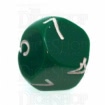

It exists. Use for whatever reason you could possibly need a d7 for.
In seriousness, there are very limited uses for this die. Maybe you could use it to randomly select a day or some shit. They're also advertised for use in seven-player backgammon games.
d8
The eight-sided die is an octohedron: one of the symmetrical polyhedra known as the "Platonic solids."

Despite being a "Platonic" solid, it looks like two pyramids caught in the beautiful act of reproduction. Long live the dice race.
A d8 was always used for hit points for Dungeons & Dragons monsters, and in Advanced D&D it was used for those classes that have more hit points but weren't supposed to be as butch as Fighters or Paladins.
Eight-sided dice also have the most variations with weird not-numbers stuff on them, like compass directions, random weather, letters. They're also used as below-bargain-basement minifigs because one point is always off the table, like a big nose, or turret.
When you played Dragon Dice, the d8s were the terrain, which could change under your feet without moving your army, somehow.
James Ernest came up with a game "Dogfight" that uses d8s for their numbers, for being pointy and for turning in circles when you try to roll them like wheels... then he remembered that people put weird shit on d8s and he came up with a new game called "DiceLand," which is a beautiful game.
Fantasy Flight Games fucking *loves* themselves some d8s. Their games make you wonder if all their parents were killed in a horrible cube-shaped accident.
Also the Fifth Angel is a huge floating d8.
d10

It's a die. With ten sides. Pretty simple concept.
It's in the shape of a pentagonal trapezohedron. You can stand it on its point and spin it like a top. You should not do this, however, as it is the universal sign of boredom and is considered faux pas in most gaming circles.
The tenth side usually bears only a zero, but you should still read it as "ten" because you want your result to be 1-10, not 0-9.
Rolling d100 Using Two d10s

Some Systems require you to roll d100s frequently. There's a better way of doing it than rolling a golf ball with 100 sides.
Get out two d10s. Use one die to denote the singles digit and another die to denote the tens digit. Some d10s have two digits per side (see above) to make differentiating your digits easier, but you can roll d100 with any two d10, provided you specify beforehand which die is the tens and which the ones.
Reading it off is simple. Did you roll a 20 and a 4? That's a 24. A 90 and a 1? 91. A 00 and a 5? Just a 5.
The only possibly ambiguous result is two zeroes: a 00 and a 0. Obviously you rolled a 100. Why? Because the alternative is a 0 which you can never roll with any other die. That, and the system assumes a roll from 1 to 100, not 0 to 99.
Mathematically, each digit is determined in an independent manner. There are exactly 10*10=100 two-digit combinations, all equally likely. You now have a uniform distribution of 100 different results, as desired.
d12

The d12 is the loneliest die. It is used for barbarian hit dice and greataxe damage in Dungeons & Dragons. The fact that Orcs (and Half-Orcs) are both the most common barbarians and the most common wielders of greataxes, it is suspected that Gruumsh is the head of a conspiracy aiming to eliminate the d10 in favor of the d12, in order to "purify" dice sets so that they consist only of true platonic solids.
Observant smar/tg/uys will notice that d12 are the hitdice used for undead and dragons instead of the usual d8s.
d12 is the highest stats can ordinarily go in Savage Worlds or Ironclaw. BBEGs and DMPC Mary Sues can have d20, but it's hella rare.
d12 shows up in Cthulhu-themed games, like Pokethulhu or Cthulhu Dice, probably because d12 is just as beautiful and graceful as the mighty Cthulhu.
One of the few places where the d12 is not lonely, and is in fact used a great deal, is the Dragonmech campaign setting. Its chief use there is for damage rolls with mech weaponry.
Alternity was very friendly to the d12, choosing to throw the d10 under the bus instead because it wasn't far enough away from the d8 to work as a difficulty step.
Pathfinder 2e makes good use of these. Since 2d6 weapons don't exist in this system, more weapons use the d12.
If you’re on a budget, the d12 is your best friend, capable of functioning as a d3, d4, d6, and even a d10 or d8 in a pinch. Not that useful, but it can still come in handy.
d16

Used basically just in Blood Bowl to randomly select a player on a team (which has a max of 16 players). Originally introduced by the NAF in 2013 (when G-Dubs refused to license their block dice anymore), GW wised up in their 2016 edition of the game and added it to their product line, replacing the old method of drawing a chit from a cup.
d20

Your best friend and worst enemy.
Before TSR/Wizards of the Coast tried to trademark "d20", every gamer knew what the fuck an icosahedron is, and why "natural 20" is a gift from God.
The Truth About 20-Sided Dice:
There are a limited number of “twenties” in any given d20. That is, no matter how many times you roll a d20, you cannot roll another twenty once the supply has run out. These twenties can only be replenished by rolling a corresponding one with the same die. Thus every gamer is duty-bound to protect their supply of good rolls. If a friend rolls a twenty using your die, not only have they stolen your good roll, but they have doomed you to the extra one required to replenish the twenty.
Some players get excited when they roll several twenties in a row, concluding the dice are “hot”. Don’t make this blunder! This is like driving your car for 400 miles without gassing up, and then concluding that your car is a perpetual motion machine. After a few good rolls, pass the die off to an unwitting companion and let them charge it up for you.
Statisticians have known about this behavior for years. They call it “the probability seesaw”. Unlike the bell-shaped curve, in the seesaw system the odds of rolling high or low is directly proportional to what has been rolled in the past. They usually pretend this isn’t true. If a statistician hands you a die insisting that “any given roll has the same odds of rolling a one or a twenty”, it means he’s handing you a depleted die in the hopes of taking advantage of you. Don’t fall for it!
Now the secret is yours. Please put this knowledge to good use*.
*By “good use” I mean, “take advantage of other players”.
| The d20 System for role playing came later. Like eighteen centuries later. |
 |
d30

Only ever used for those critical-hit tables when you rolled a natural 20. Or if your DM was rolling damage and felt like being a dick.
But man, would it leave a bruise when your little sister threw it at your head.
d34

Yes, they exist. Apparently if you roll 3 of them and subtract 2 from the total, you get a normal distribution from 1-100, assuming that's your idea of a good time.
d50

For when you want to do 2-100 points of damage with a vaguely normal distribution.
... yeah, I don't know either
It also doubles as a golf ball.
d100

Take that, d50's!
They're useful when you really want to take 5 minutes to find out if you hit something in Dark Heresy. In other words, better just use a pair of D10's like a normal human being.
Apparently it took about 6 years to make this die. I guess this means that it takes 6 years to put the numbers 1-100 on a fucking golf ball.
Usage
It may seem awesome when you see it, but as soon as you get one (and whoever's selling it to you is also aware of how unspeakably lame it is, and will probably even tell you) you will find that it has two major flaws: it takes about a minute to stop fucking rolling around and if you aren't blessed with a perfectly level playing surface you will never find out exactly what you've rolled (and when there are six other numbers right next to the 100 and 1, that's a pretty big problem). Oh, and to top it off, it isn't even very balanced, so it's effectively a loaded die.
On the other hand, if you hate your friends, show up to your next meeting and sweep all the d10s off the table, then drop your d100 right in the middle with a theatrical gesture and watch as everyone is mesmerized by its incessant rolling (see: takes about a minute to stop fucking rolling around). Take this opportunity to pocket the d10s, run away and never come back.
FATAL seemed to expect you to use this (but then again FATAL expects you to play FATAL so you can't expect much).
Seriously, though, let the cat play with it so they'll keep away from the other dice.
d120
This is the most number of sides that a die can have while being 'mathematically fair die' (that doesn't have the dual problems of rolling forever and being prohibitively hard to read). The d120 stops rolling after a reasonable time (with the condition that this only applies if you don't roll with 'too much force'). It is also a bit tricky to read (but still perfectly possible). The company that sells the die points out that it can act as any of the standard 7 dice (d4, d6, d8, d10, d10 of 10s, d12, and d20). And thanks to the chart they released for free, you don't even have to do the math yourself [1]. Of course for the d100 roll you'll have to roll the d120 twice, roll 2 d120, or use a die other than the d120 (although you could still use the d120, e.g. a d10 and a d120). [2]
Barrel Dice

Those weird-ass dice you find on that one dusty shelf behind the counter of your game store. Rather than platonic shapes with numbers on each side, it's a prism shape rounded at the ends, with numbers on the long sides. While not particularly popular, they're an excellent option for d4s, since they don't feel like the torture of a thousand hells to step on. Supposedly, they roll more evenly without as much bias and are harder to "throw", but the larger ones have the same problem as d50s. Hell, a barrel d50 would never ever stop rolling.
If you're super poor and can only afford the pencils and paper for your pencil-and-paper RPGs, your can use your pencils as barrel d6s.
Other dice
There's other dice as well that are produced for... Reasons. While a d3s, d7s, or d100s at least have a use, there is no real use for a d13 or d25. Most of these are just d10s with more sides (so really just a spinning top), though some are more rounded d12s, which make them favor one side above others most of the time. If you can find a use for it, good on you. Otherwise they are just novelties to gawk at and never roll. That said, certain types of dice were found in tombs, like the d14 and d18 found in Chinese tombs.
Crayola Dice
| This article or section is about something oldschool - and awesome. Make sure your rose-tinted glasses are on nice and tight, and prepare for a lovely walk down nostalgia lane. |

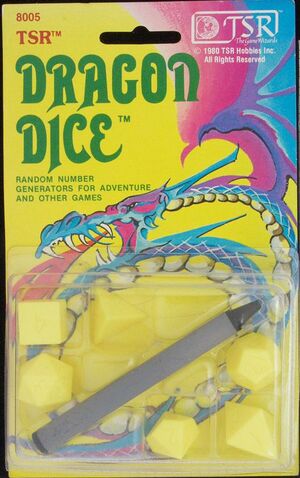
Are you old enough to remember when dice didn't have inked or painted numbers? With the old D&D games, you got soft plastic powder blue dice and a soft white and red crayon. In order to see the numbers you had to fill in the etched spots with the wax.
There were no d10's either. The d20 was labeled 0-9 twice (fit 2 digits on a die face? IMPOSSIBLE!) so you colored one half of the numbers white and the other half red. It acted as your D10, and if you needed a d20, you declared one color to be +10 before you rolled.
These dice were made out of pretty soft plastic, and after 25 years, most of mine don't even stop rolling anymore. No more corners.
This has been a bout of nostalgia.
Narrative Dice
Made popular by Fantasy Flight Games, these dice look like typical dice at first glance but then one notices a severe lack of numbers and instead each die having blank sides, sides with one symbol or another, or sides with two symbols. They also tend to be more expensive than your typical bog standard set due to this.
Where they shine, though, is that they can give you not only success or failure like typical numbered dice, but other symbols grant advantage or threat. The whole thing with these is to pick up enough "good" dice and the amount of "bad" dice your GM allots you, roll them all, the cancel out the opposing symbols on both axes described above which can net you much more variety in possible outcomes. Things like "I failed to hit but now my allies have advantage," or "I hit but got a lot of threat so now the enemies can do some crazy shit" are possible.
Gallery
-
Premium Dice!
-
Premium Dice cont.
-
A d4 in the wild, natural weapon readied. As you can see by the notch on the left edge, this one has already claimed a victim.
-
Now that's just sick and wrong.
-
-
Try and MAKE me go outside. Fuck off, d12.
-
Even camwhores know that the d20 is sexy, and each face has an exactly 5% chance of appearing.
-
It is said if not for the trusty D4 the Union would never have one its independance from Britain and the reason no one can beat Russia. As Russia's savage wilds are famous for its saber toothed white furred D4's to defend the motherland.
-
-
There are people who hate dice, those people are wrong.
-
We're Number One
-
-
See Also
- Chits - The nega-dice of yesteryear.
- Dice pool
- Exploding die
- Fudge dice
- D6 System
- D20 system
